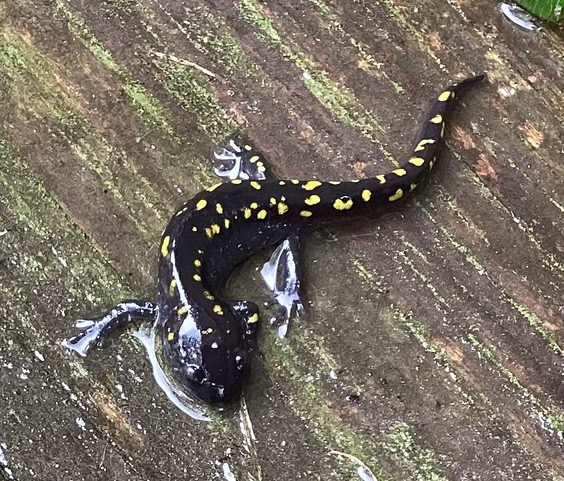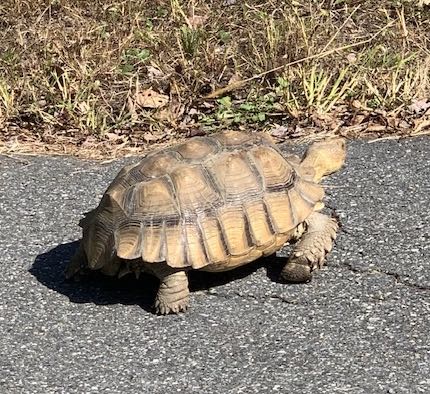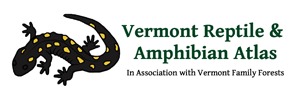
Herp Update: Amphibians on the move & Fall Calls, Snake Monitoring Video, Non-native Species – October 17, 2023
Recent and Upcoming Herp Activity
Amphibians still on the move
After my wife mentioned that an Eastern Red-backed Salamander had found its way into her studio yesterday evening, I decided I should run over to our local amphibian crossing hotspot (Morgan Road in Salisbury) to see what was moving. Although it was not raining when I was there, it had rained lightly off and on during the day, the ground was still wet, and the temperature was about 50°F. I was surprised that although we have not had a frost here, the insects had stopped calling and it was perfectly quiet. In addition, there were no leaves on the road at all (no wind), resulting in excellent visibility. In my 20-minute walk through the crossing area I found 52 Eastern Red-backed Salamanders, 18 Four-toed Salamanders, 6 Blue-spotted Group Salamanders, and a single American Toad. I was really interested to see that the great majority of the Four-toed Salamanders were this years’ young (about 2 inches long) headed upslope to overwinter for the first time.
Amphibians still calling
I was surprised last night to hear a couple Wood Frogs making fall calls from the nearby woods along Morgan Road. Wood Frogs calling in October or later have been reported only five times compared to four reports of Gray Treefrogs, two reports of Northern Leopard Frogs, and 93 reports of Spring Peepers calling after October 1. Most of these calls do not sound the same as their spring calls, nor are they usually from wetlands or ponds as they are in the spring. Spring Peeper fall calls are much shorter and usually made from the leaf litter. Both Wood Frog and Northern Leopard Frog fall calls are more muted than their spring calls. On the other hand, Gray Treefrog fall calls sound the same to me as their spring calls.
Young Spotteds and Blue-spotteds also on the move
Over the last week we have received numerous reports of young-of-the-year Spotted and Blue-spotted Salamanders moving upslope to overwintering locations, also for their first time. I suspect these salamanders have only been out of their natal wetlands about six weeks or less and they are taking advantage of our recent rains to move. Some of them ended up in buildings and one in a dog’s water bowl (see photo from Jayne Shoup).
New monitoring video
Film maker Jill DeVito contacted us early this fall to ask if she could make a video of our snake monitoring for her YouTube channel. She joined us for the morning about three weeks ago and has just made her video available. It lasts about 18 minutes, and should be informative for those of you interested in building your own snake hotel or snake covers. You can check it out at:
Annual Report
Here is another piece of our annual report for Vermont Fish and Wildlife’s State Wildlife Grant.
Every year we receive a few reports of non-native reptiles and amphibians that were either released or escaped pets or were accidentally transported via boats, trucks, RVs, and cars. We received a report of a Green Anole (Anolis carolinensis) from East Montpelier that appears to have come to Vermont on an imported house plant. We received a report of an African Spurred Tortoise (Centrochelys sulcata) in Albany that was an escaped pet. We received a report of a River Cooter (Pseudemys concinna) in Burlington that is now in a classroom. This also was likely an escaped or released pet. We entered a report of a Cuban Treefrog (Osteopilus septentrionalis, from early 2022) found in a house in Burlington. It also likely came in with house plants. An Eastern Fence Lizard (Sceloporus undulatus) showed up on a porch in Rutland (unknown origin). Lastly, two Pond Sliders (Trachemys scripta) were reported. One was in Arlington and the other in Windsor. This is a common pet turtle species that has become invasive in southern New England. As our climate continues to warm, they could become invasive in Vermont.
Of the above species, only the Pond Sliders have been able to survive Vermont winters out doors. This makes them more of a concern. Don’t release non-native pets.
The photo below of an African Spurred Tortoise was taken by Douglas LaPoint.



